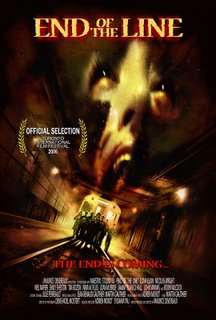TIFF 2006: "END OF THE LINE"
 (Canada First)
(Canada First)
2006, Canada, 95 minutes
Written and directed by Maurice Devereaux
Cast: Ilona Nelkin, Nicolas Wright, Robin Wilcock, Neil Napier
A rare genre entry screened outside of the "Midnight Madness" programme--the latest low-budget gorefest from Montreal's prolific Maurice Devereaux barely registered a blip on my "Creep-O-Meter", to borrow an expression from the film’s leading man. This extended fan-film (that somehow won over the tolerances of the TIFF programmers) will do little to alter the non-disciple’s view of horror as anything more than adolescent trifle, but forgiving gorehounds will respond to the admittedly impressive splatter FX.
The brisk setup prepares us for an apocalyptic nailbiter on an epic scale, with multiple plot threads and characters piled on like Alejandro Gonzalez Innaritu helming a “Left Behind” adaptation: Karen (Nelkin), a young psychiatric nurse, finishes a hectic shift at an unnamed big city hospital. The patients are unruly and spouting end-of-times babble (a bit late with nearly six years having passed since fin de sicle); with one so spooked he tries to eat his rosary. Earlier that day, one of her cases committed suicide by jumping in front of a subway train, but not before leaving her some eerie sketches depicting the hospital and the city overrun with demons.
Waiting for the last train home, Karen is accosted by a vulgar Patrick (Wilcock) but sensitive Mike (Wright) comes to her rescue by posing as her friend. The lanky, unassuming college boy is an obvious intellectual—evidenced by his dog-eared Carl Sagan tome (my guess is that it’s “The Demon Haunted World”, but I can’t say for sure)—but admits he listens to his internal “Creep-O-Meter” when detecting potential ne’er-do wells. Meanwhile on another car, horny teens John and Sarah (in this film, this is what qualifies as the “meanwhile” subplot…) seize the opportunity to get busy (their modesty preserved by keeping on their clothing). And creepy Patrick has wandered between cars to seek out female prey, which he finds in the form of Julie, a comely music student.
The train stops abruptly in the tunnel. While the conductor investigates, a frightened middle-aged woman enters Karen’s car for company until power can be restored. “Betty” seems harmless until her beeper goes off. Inspecting the text message, she pulls a blade from her crucifix and sinks it into Mike’s back, cackling madly that everyone must be “saved”. Elsewhere, on other equally-under populated cars, beepers sound and identically-clad disciples—including Patrick to no one’s surprise--begin attacking the other passengers (one absurdly brandishing a cutlass so long he could’ve stepped from the cover of a George MacDonald Fraser novel!), but failing to stop strapping Neil (Napier) from getting away.
Karen, Mike, Neil, John, Sarah, and Julie flee the train with the murderous zealots giving chase through the tunnels. They eventually secure shelter in a supply room, along with two panicky transit grunts. Arguments ensue about the next course of action, with some voting to stay and others to keep moving (this scene is so reminiscent of the “cellar” debate in “Night Of The Living Dead” that I’m convinced one of the workers was cast for his uncanny resemblance to Duane Jones). They agree on this: devotees of (irony alert) Reverend Hope have been programmed into enacting a bloody “cleansing” of mankind and that the scope of these attacks is not known (a TV broadcast from the fanatical guru suggests a global Armageddon). And soon, it’s revealed that no one can be trusted, as some possess hidden loyalties to Hope’s cult.
The digs at right-wing fundamentalism are so maddeningly toothless that one wishes they could be dismissed as “heavy handed”, just to say someone tried to shoehorn in some subtext. Two films from John Carpenter’s self-described “apocalypse trilogy”—“Prince Of Darkness” and “In The Mouth Of Madness” (the other is “The Thing”)—are obvious inspirations and both eventually delivered on their off-camera baddies (“The Anti-God” and “Sutter Cane”, respectively). Reverend Hope is barely a presence in EOTL, glimpsed briefly on a hospital banner, in his televised manifesto, and from some pamphlets conspicuously placed on the subway platform.
“End Of The Line”s subterranean location will invite inevitable comparisons to Gary Sherman’s “Raw Meat/Deadline” and Christopher Smith’s “Creep”, but those superior efforts used the locale as a character and were directed with considerable panache. EOTL is not especially scary, even in a workmanlike sense, save for a few shock cuts (usually prescient dream sequences) and music stings cribbed from the Carpenter songbook. Nor is it overtly stylish (which saved Canuck slasher drivel like “Terror Train” and “My Bloody Valentine”), with the production design seemingly based on found locations (even the cast looks to have brought along their own wardrobe), and the HD-cinematography soft and too-evenly lit to serve so many master shots.
On the plus side, Adrien Morot’s makeup FX realize some truly eerie spectral baddies and the copious bloodletting is excruciatingly convincing, if a tad Herschell-Gordon-Lewis-excessive. One suspects that they are the reason “End Of The Line” was conceived in the first place, with the “Night Of The Living Fundamentalists” hook an easy one on which to hang a series of gags.
In his exhaustive chronicle “They Came From Within: A History Of Canadian Horror Cinema”, author Caelum Vatnsdal defines the typical Canadian horror film as “a cinema of moments, rich with unlikely imagery, baffling storylines, and bizarre narrative twists….and largely unintelligible, usually accidental, subtext.” These dubious qualities definitely apply to “End Of The Line”, but considering that this country has also produced the oeuvre of David Cronenberg, and funded superior genre efforts such as “Ginger Snaps”, and “Cube”, the fact that Devereaux worships at the altar of David DeCoteau is a depressing one.
-Robert J. Lewis



